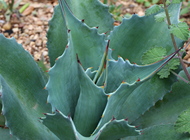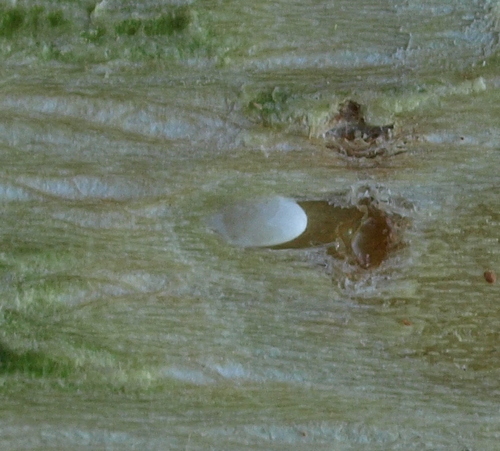The settingA couple of years ago, as we were working on adding some local color to our backyard, we went on a shopping spree at a native plant nursery. We bought several trees that day, and all are doing nicely in our garden. But the one that's happiest of all is our huisache (Acacia farnesiana), which quickly grew to several times its original size, and has since treated us to yellow pom pom flowers in spring. It is "very native" – not just to the state of Texas, but to our area, where most wouldn't consider it a desirable garden tree because of its fierce spines. I'm quite pleased with it though, and hope it continues to grace our garden for many years to come. And until recently, I had little reason to doubt it would – it's cold-hardy, drought-tolerant, and pests didn't seem to bother it. A rock of a tree, in other words. The first attackSo I was a little surprised to see, when I walked out into the backyard one day a few weeks ago, that one of the sizeable upright branches of our tree had collapsed. We'd had no strong wind, or anything else that would explain the sudden break, so I investigated closely. The branch, a little more than an inch in diameter, had fallen forward, and was still partly attached to the tree. Its heartwood had splintered, making the irregular jagged break that I would expect to see. But the wood along the back of the break was curiously smooth-cut. At that time, I didn't think too much more about it; I cut the branch off and chipped it for the compost pile, and the tree wasn't much worse for the wear. I didn't even take a picture. The second attack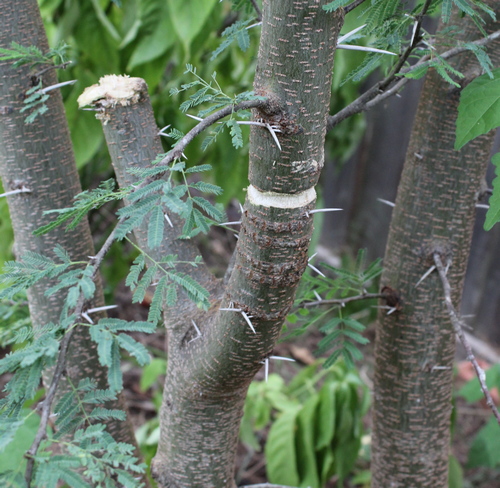
Just a few days later, I was out walking in the garden again when I noticed that a second upright, a larger branch (actually, one of the trunks of the multi-trunked tree), was completely girdled. The damage area was close to where the first branch had broken, at almost exactly the same height. The cut was fairly clean-looking and regular, and there were bits of sawdust-like wood debris on the ground below. In the photo at right, you can see the place where the first branch succumbed in the back, and the newly damaged one in the foreground. Now I realized there was something more going on. Were my neighbors, unhappy with such a thorny tree growing near our fenceline, sneaking into the backyard and undoing the tree a little bit at a time? Nonsense, of course. How about our new puppy, who loves to chew on everything? No way she has the dental dexterity to cut smoothly around a branch. But then what could it be? I did as I usually do on these occasions: I consulted the internet. By force of habit, my first stopping place is the Houzz gardening forums, current home of the old Gardenweb forums. I posted a picture of the damage in the Texas Gardening and Trees forums, and sure enough, before too long I had an answer: it appears that my tree was under attack by a huisache girdler! Mighty mini-beaversHuisache girdlers (Oncideres pustulata), I learned, are long-horned beetles. The genus Oncideres is home to several twig-girdling species, but the species O. pustulata apparently specializes in huisache trees and close relatives tepeguaje and mesquite. Its natural range extends from Texas to northern Mexico. Adults come out to mate in fall (late August through October), after which the females deposit their eggs underneath the bark of one of their host trees. Apparently it would be inconvenient for the developing larva to have to contend with tree sap, so mama then proceeds to girdle the branch underneath (that is, closer to the roots) the oviposition point, effectively stopping the flow of sap. It also effectively (over time, in any case) kills the branch, which falls to the ground when it's dislodged by wind. The larva proceeds to feast on the dead wood, eventually emerging as an adult the following summer. From what I've found in online reading, branches attacked are usually smaller in diameter (9-12 mm) than the ones that were selected by my girdling visitors, but girdlers are known to take on quite large branches as well. While I'm not averse to letting native insect species do their thing in my garden, I wouldn't mind if they picked on some smaller limbs in their future child-rearing endeavors! Return of the girdlers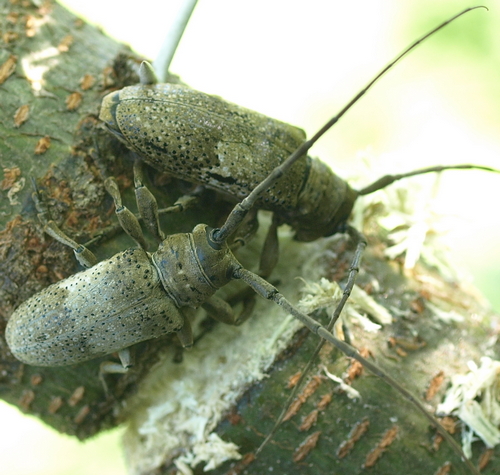
Several days after I noticed the second attack, I got a text from my son, a woodworker and tree enthusiast who had been following the unfolding story. He had caught two of the beetles in the act, at least one of them chewing away at the same notch – apparently, the cut wasn't deep enough for their tastes. He took the picture at left, and captured one of the girdlers; the other ran off (surprisingly fast, he reports) and is still at large. The notch was noticeably deeper as a result of these renewed efforts, and by the next day, the limb had started to sag under its own weight, even though the girdling hadn't done any damage yet to the foliage. A photo session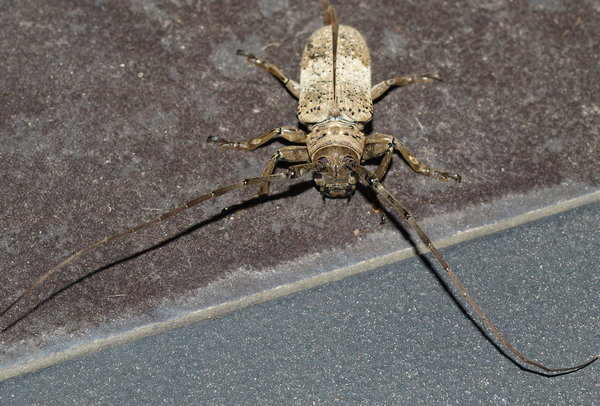
Showing off its long horns The captured girdler was subjected to an extended photo shoot in a couple of indoor and outdoor locations: I find that my camera with close-up lens allows me to see detail that I cannot hope to see with my (aging) bare eyes, and these are interesting-looking creatures. The specimen may be a male (Ben captured the slightly smaller one that wasn't actively chewing in the photo above, and chewing is the mother's job among girdlers). Its body is close to an inch long (the antennae are of course much longer, as befits a long-horned beetle), and its wing casings are covered in shiny black spots (the "pustules" or pimples to which its species name refers), the underlying color divided into three cross-wise bands of different shades of grayish-brown. 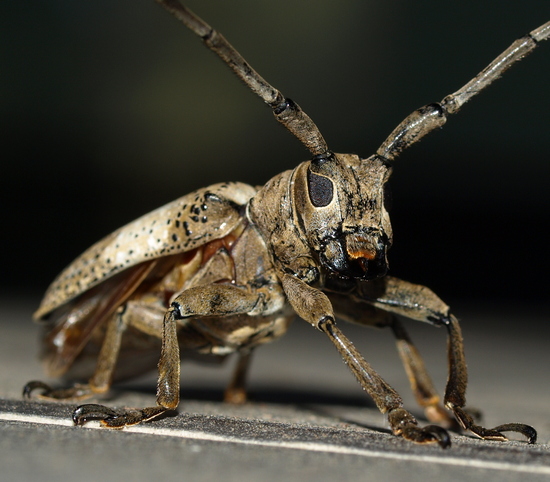
Beefy mandibles. This photo also shows why this species is classified among the flat-faced longhorns. The mandibles on female twig girdlers are extended, to make for heartier chewing. Even the chewing pieces on the one that sat for my shoot (again, likely male) look pretty fierce. I was happy with this picture – in full resolution, it shows the faceted eyes, as well as the furry hair covering its face and legs.

Shiny black dots cover the subtly banded wing covers A few more photos for good measure. This one shows the characteristic markings and color bands typical of the species. I've seen a good bit of variability in coloration in online photos; in some, the banding isn't nearly as regular or prominent.
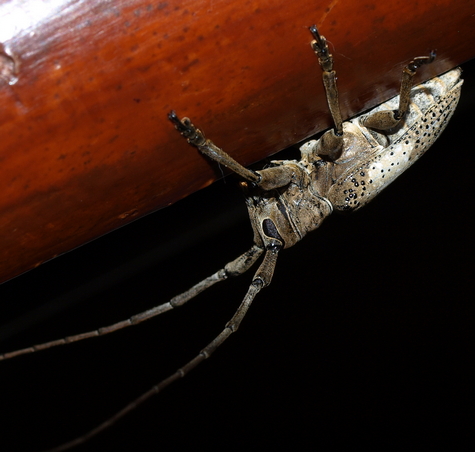
Side view My temporary guest was fairly docile during the photo shoot, thanks no doubt to some time spent cooling off in the family fridge. Once he started walking around on our table, he did scoot to the underside, which allowed me to take a nice upside-down side shot. A little later, out on the patio table where I took some of the other pictures, he demonstrated that he can fly, even though it seems they don't fly much when they're in a happy place. But that's undoubtedly how they found the only huisache growing in my entire neighborhood – scanning for a happy place from overhead!
The aftermath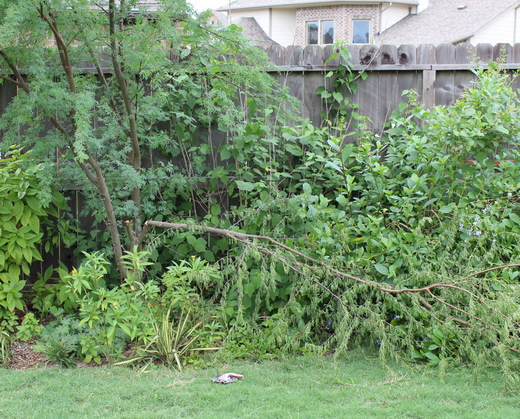
A few days later, the second limb came crashing down under its own weight. As a result, the tree has lost about a third of its crown, but since it's otherwise healthy and fast-growing, I'm not too concerned over the long-term effects of the girdler attack. Still, I think I'll be monitoring the tree more closely in early to mid autumn from here on out.
The incubation time for girdler eggs is reportedly about 7 days; since more than a week had passed between the initial attack on limb number two and its collapse, I decided to strip the bark off the section of the branch closest to the notch to see if I could find any larvae. I didn't find any, but did see this feature, which looks like an egg, about an inch up from the notch. Since we'd been having some colder weather, I figured the egg may need a little longer to hatch. So I covered the stripped section with some tape to maintain a protected environment. Thus far, no further sign of life...
Visitors to this page have left the following comments
I welcome comments about my web pages; feel free to use the form below to leave feedback about this particular page. For the benefit of other visitors to these pages, I will list any relevant comments you leave, and if appropriate, I will update my page to correct mis-information. Note that I discard any comments including html markups, so please submit your comment as plain text. If you have a comment about the website as a whole, please leave it in my guestbook. If you have a question that needs a personal response, please e-mail me.
Last modified:
October 30, 2019 |
|||||||||||||||||||||||||||||||||||||||
